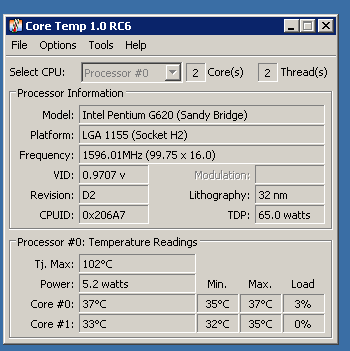^^Which is a good point if you don't compare like to like. My G620 idles at 5W and full load is under 15W (one core full load). The i3 3220 is very similar, maybe half a watt lower. The above chart is a like to like reading and with the total system - not just CPU so the 4W difference at full load seems plausible and bring the 620T to a level very similar to your CeleronU. Of course, we are reading from three different units, but approximations are fine for the purposes of discussion.
If you do get a PicoPSU for a IVB/Haswell and compare directly to your Celeron, even a basic IVB Pentium consumes not as much power as the difference in TDP would have you believe. The difference, of course, is that the mobile variants and T versions have a much larger number of sleep states that help the OS fine-tune the power consumption further. However where battery is not the primary power source, the additional savings are negligible.
The point is that differences in power consumption at desktop level will not work out because you still have to power a monitor at least, which adds 25-35W to the footprint (in my case, 150W). Plus a disk - SSDs can be upto 3 to 4W, mechanical drives twice that. In that scenario, saving an average of 3-4W per running hour does not seem significant, at least not to me. The best way is to go off-grid - tablet/laptop. Desktop power optimisation is still a losing game. I went through this exact dilemma a few months ago, solved by buying a tablet. Just that saved me about 300/- a month on electric bills, it would have been more except that I started gaming in the evenings and that machine sucks down over 500W.
We've also long spoken of power efficiency and IPC 'bottom', which basically means there is a sweet spot between power consumption and efficiency and if the performance suffer to the point of tasks taking too long to finish, power savings are counterproductive. Intel has long suffered this fate in mobile, Haswell is really the first step to getting very efficient structures in place to ensure that power savings do not compromise system efficiency. Which is why you can see the emergence of the x86 (well, almost) mobile game console, which was kind of a stupid idea before IVB and Haswell came along.
If you do get a PicoPSU for a IVB/Haswell and compare directly to your Celeron, even a basic IVB Pentium consumes not as much power as the difference in TDP would have you believe. The difference, of course, is that the mobile variants and T versions have a much larger number of sleep states that help the OS fine-tune the power consumption further. However where battery is not the primary power source, the additional savings are negligible.
The point is that differences in power consumption at desktop level will not work out because you still have to power a monitor at least, which adds 25-35W to the footprint (in my case, 150W). Plus a disk - SSDs can be upto 3 to 4W, mechanical drives twice that. In that scenario, saving an average of 3-4W per running hour does not seem significant, at least not to me. The best way is to go off-grid - tablet/laptop. Desktop power optimisation is still a losing game. I went through this exact dilemma a few months ago, solved by buying a tablet. Just that saved me about 300/- a month on electric bills, it would have been more except that I started gaming in the evenings and that machine sucks down over 500W.
We've also long spoken of power efficiency and IPC 'bottom', which basically means there is a sweet spot between power consumption and efficiency and if the performance suffer to the point of tasks taking too long to finish, power savings are counterproductive. Intel has long suffered this fate in mobile, Haswell is really the first step to getting very efficient structures in place to ensure that power savings do not compromise system efficiency. Which is why you can see the emergence of the x86 (well, almost) mobile game console, which was kind of a stupid idea before IVB and Haswell came along.








